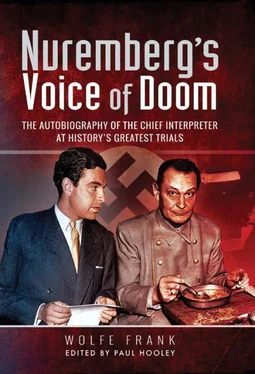Lord Mount Temple was Chairman of The Anglo-German Fellowship, an organisation which existed from 1935 to 1939, and which aimed to build up friendship between the United Kingdom and Germany. Having publicly stated that membership of the Society did not assume support for Nazism or anti-Semitism, Lord Mount Temple resigned in November 1938 because of the Nazis treatment of German Jews.
Ulrich Friedrich Wilhelm Joachim von Ribbentrop (1893–1946), more commonly known as Joachim von Ribbentrop, was Foreign Minister of Nazi Germany from 1938 until 1945, having served as German Ambassador to the United Kingdom from 1936. Ribbentrop was tried at Nuremberg and convicted for his role in starting the Second World War and enabling the Holocaust. Ironically, after having assisted Wolfe Frank to get his wife’s passport back, it was Frank who interrogated him, interpreted at his trial and announced to him the sentence of the court. On 16 October 1946 Joachim von Ribbentrop became the first of the Nazi war criminals to be hanged.
Albert Frank (1835–1894), Wolfe’s grandfather, was an industrialist and head of the metal-ware company of the same name. The company was well known for the manufacture of parts for automobiles and bicycles and a wide range of lanterns that bore the company’s well-known ‘Muncher Kindl’ (Munich Child-Angel) logo.
Wolfe’s father, Ferdinand Frank (1866–1933), was the son of Albert Frank and his wife Bertha (née Pappenheimer). He took over as head of the family business following his father’s death and floated it on the Berlin Stock Exchange in 1914 under the name Frankonia AG on the expectation of large military orders (see photographs of Frank family and the Frankonia factory at Plates 3–5). The company had factories in Beierfeld, Berlin-Adleshof and Elbing. Prior to his marriage to Wolfe’s mother (Ida) Ferdinand had been married to, and divorced from, Alice Frank (née Rosenbaum) who later died in a concentration camp. The couple had two children Maria, who also died in a concentration camp, and Olly. Busts of these two children were carved in the home that Ferdinand had designed – possibly by the famous German architect Erich Mendelsohn – and built in Beierfeld (see Plate 6).
Wolfe’s mother, Ida Therese Frank (née Hennig), was born in 1879 in Leipzig. She was the daughter of a retired Gas Inspector. Ferdinand and Ida were married at the Register Office, Hackney, London, on 9 April 1908. At the time of the marriage Ferdinand was residing at the Cecil Hotel in the Strand and Ida at 10 Portland Road, Finsbury Park. A fortnight later, on 24 April, the couple were also married in Munich.
Wolfe was originally named Johann Wolfgang Frank, and then Hans Wolfgang Frank. He later became Hugh Wolfe Frank – the name under which he was granted British passports and, in 1948, British citizenship – however he preferred to be known as Wolfe Hugh Frank or just plain Wolfe Frank.
Wolfe attended an elementary school in Beierfeld and Grunewald Gymnasium in Berlin, a grammar and boarding school for boys, until ‘Mittlere Reife’ (pre-college examination).
Berlin Institute for Practical Mechanics.
Documents have been discovered that show Ferdinand was himself a member of the Jewish faith whilst his wife Ida and Wolfe were both Protestants.
The Field Marshal’s Hall.
The Court Garden in the centre of Munich.
Mein Kampf ( My Fight ) is a 1925 autobiographical book by Adolf Hitler. The work describes the process by which he became anti-Semitic and outlines his political ideology and future plans for Germany.
The Beer Hall Putsch, also known as the Munich Putsch was a failed coup attempt by the Nazi Party leader Adolf Hitler, in November 1923, to seize power in Munich.
The Sturmabteilung (SA) – Storm Detatchment – was the parliamentary wing of the Nazi Party. Its members were known as ‘Brownshirts’ because that was the colour of the uniform they wore.
The Horst Wessel Song, also known by its opening words, Die Fahne Hoch ( The Flag on High ), was used as the anthem of the Nazi Party from 1930 to 1945.
Dachau was the first concentration camp to be opened (in 1933) in Germany. It was located in Bavaria about ten miles northwest of Munich.
‘The Night of the Long Knives’, also called Operation Hummingbird or, in Germany, the ‘Röhm Putsch’, was a purge that took place in Nazi Germany from 30 June to 2 July 1934, when the Nazi regime carried out a series of political raids intended to consolidate Hitler’s power. Many of those killed were leaders of the Sturmabteilung (SA), or Storm Detachment, the Nazis’ own paramilitary organization, colloquially known as the ‘Brownshirts’ due to the colour of their uniforms. The best-known victim of the purge was Ernst Röhm, the SA’s leader and one of Hitler’s long-time supporters and allies.
The name ‘ Kristallnacht ’ comes from the shards of broken glass that littered the streets after the windows of Jewish-owned stores, buildings, and synagogues were smashed.
Rassenschande (racial shame) was a concept in Nazi Germany’s racial policy forbidding sexual relations between Aryans and non-Aryans.
Gregor Strasser was another prominent Nazi official and politician who was also murdered during the Night of the Long Knives in 1934 (see note 2 to Chapter 4).
A decorated wooden framework supporting the coffin of a distinguished person during a funeral or while lying in state.
The German Government placed the liquid assets of German Jews in special blocked accounts known as ‘Sperrmarks’ which could only be used in Germany. Those Sperrmarks held their value internally but had much less value (perhaps as low as 25%) outside the country. To purchase goods (such as cars) in Sperrmarks and then sell those goods abroad was one way of getting a better exchange rate – however such transactions were soon made illegal by the Third Reich. Similarly smuggling banknotes out of Germany – which could be exchanged at true market value for Swiss Francs was also a crime that carried the severest of penalties. Francs obtained through such transactions could then be used to buy Sperrmark funds in Switzerland at extremely advantageous rates. Those Sperrmark funds could then in turn be used to pruchase shares in German companies. This was a hugely profitable, albeit highly dangerous, way for German Jews to use the financial system to their advantage.
The Krupp Trial (officially, The United States of America vs. Alfried Krupp, et al. ) was the tenth of the twelve SP trials at Nuremberg. Twelve former directors of the Krupp Group were accused of having: enabled the armament of the German military forces; actively participated in the Nazis’ preparations for an aggressive war; and used slave labourers in their companies. Wolfe Frank indicates elsewhere in his papers that ‘Alfried Krupp was found guilty at Nuremberg and sentenced to twelve years in prison of which he only served five! However even as his trial was approaching its climax, the Germans were busy restoring him and their “elite” to their un-lost glory’.
Читать дальше












